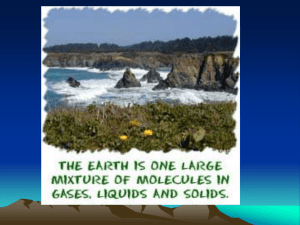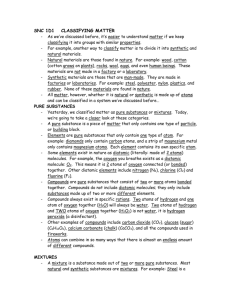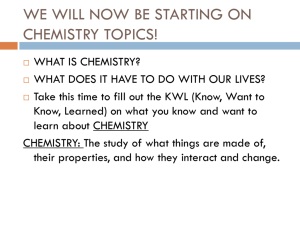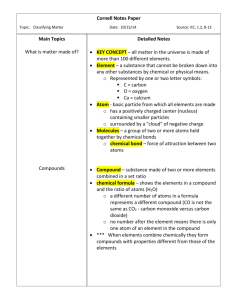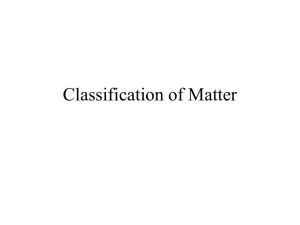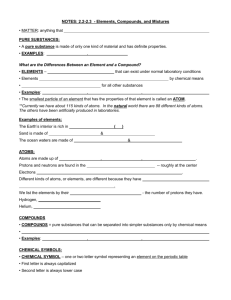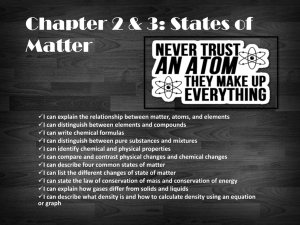Describing Matter
advertisement
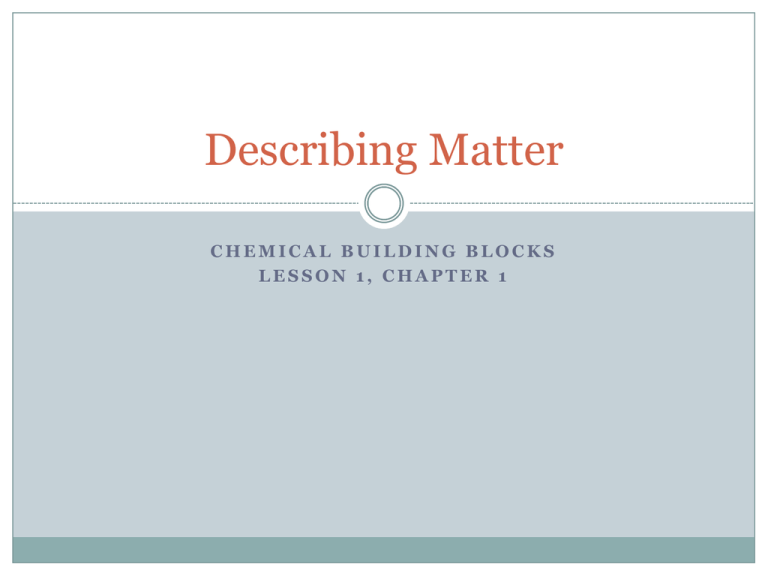
Describing Matter CHEMICAL BUILDING BLOCKS LESSON 1, CHAPTER 1 Matter Matter is anything that has mass and takes up space. All the “stuff” around you is matter and you are matter too. Air, plastic, metal, wood, glass, paper, and cloth are all examples of matter. Properties of Matter Chemistry is the study of properties of matter and how matter changes. The properties and changes of any type of matter depend on its makeup. Some types of matter are substance and some are not. In chemistry, a substance is a single kind of matter that is either pure or a composition. Pure substances always have a specific makeup. Composite substances always have a specific set of properties. Example For example: table salt has the same composition and properties no matter where it comes from – seawater or a salt mine. On the other hand, think about the batter of blueberry muffins. It contains flour, butter, sugar, salt, blueberries and other ingredients. Some of the ingredients are pure, while others are not like the batter. The batter is not pure because it contains several ingredients that can vary with the recipe. Physical vs. Chemical Properties Every form of matter has two kind of properties – physical and chemical properties. A physical property is a characteristic of a pure substance that can be observed without changing the other substance. EX: when liquid water freezes. It is still water even though its appearance has changes. A chemical property is a characteristic of a pure substance that describes its ability to change into a different substance. EX: Flammability – When wood fuels a fire that produces heat, gases, and ash. Physical properties include: Physical State Texture and color Flexibility Chemical Properties include: Flammability Ability to react New substances, New properties. Elements Around 400 B.C. a Greek philosopher named Empedocles proposed that all matter was made of four elements – air, earth, fire and water. All matter in the universe is made of slightly more than 100 different substances, still called elements. Elements are the simplest substances. Each element can be identified by its specific physical and chemical properties. Atoms What is the smallest possible piece of matter? An Atom An atoms is the basic particles from which all elements are made. Different elements have different properties because their atoms are different. Atoms of most elements have the ability to combine with other atoms. When atoms combine, they form a chemical bond, which is a force of attraction between two atoms. Atoms combine to form larger particles called molecules. Molecules are groups of two or more atoms held together by chemical bonds. Compounds All matter is made of elements, but most elements in nature are found combined with other elements. A compound may be represented by a chemical formula, which shows the elements in the compound and the ratio of atoms. When elements are chemically combines, they form compounds having properties that are different from those of uncombined elements. Mixtures Elements and compounds are pure substances, but most of the materials you see everyday are not; They are mixtures. A mixture is made up of two or more substances – elements, compounds or both that are together in the same place but not chemically combined. There are two main types of mixtures: Heterogeneous Mixtures and Homogeneous Mixtures. Heterogeneous vs. Homogeneous Mixtures In a heterogeneous mixture you can see the different parts. Ex: soil and a salad. In a homogeneous mixture, the substances are so evenly mixed that you can’t see the different parts. Ex: Air A solution is an example of a homogeneous mixture. Separating Mixtures There are four main ways in which to separate a mixture: 1. Using a Magnet 2. Filtering the Mixture 3. Distilling a Liquid Solution 4. Evaporation




